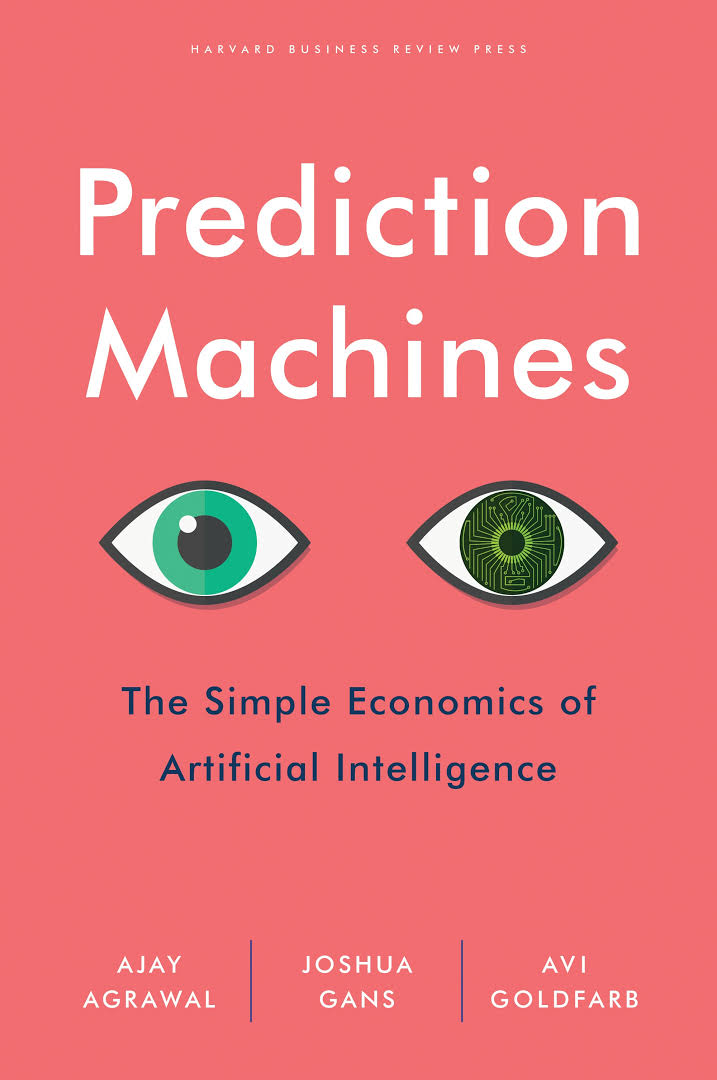Prediction Machines
The Simple Economics of Artificial Intelligence


The authors are all senior professors at the Rotman School of Management, University of Toronto. Agrawal and Gans are professors of Strategic Management and Entrepreneurship and Goldfarb of Marketing. They have started the tech start-up executive program at Rotman "The Creative Destruction Lab" (CDL) where they are Founder, Chief Economist and Chief Data Scientist respectively. Collectively they represent a polymathic group, who are exposed through the CDL to a wide range of tech start-ups.
Artificial Intelligence is currently gripping the business world, being the next step on the journey from Big Data to full automation. For business executives it is often a slightly mystical concept, offering both dramatic cost-cutting opportunity as many routine human roles are replaced with ever-present, ever-reliable machines, and also threatening many long-standing businesses with being swept away like horse-drawn carriages with the coming of the automobile. Currently, the truth is less dramatic with AI tools making incremental advances and their limitations being as frustrating as their prospects are alluring. This journey is just beginning.
The authors premise is that, for the moment, and that will be some good few years into the future too, AI can be simply viewed as bringing statistical analysis to businesses very cheaply. Whereas a handful of years ago only the largest organizations could afford to crunch collected data on any scale, and loop back their findings to refine them, now computers can do this at very little cost.
They liken AI to the arrival of electric light. Previously burning a candle or oil lamp had a material cost, but flicking a light switch is an essentially costless exercise (in as much as we might be cost and energy conscious of turning lights off, but rarely pause about switching them on). The advent of such cheap lighting changed the word, for the first time in history humans were no longer restricted to working in daylight hours, and the productive day extended (for better or worse) into a 24-hour opportunity. So, the authors posit, with AI. Until now it has been costly to get useful statistical predictions from data, today it is essentially costless. And as the cost disappears the range of uses prediction can be put to widens.
Today we collect data on heart data from 'wearables' and can use that information to predict health patterns; Google collects mobile phone location data to predict traffic jams; Grammarly uses text data to 'predict' correct spelling and usage. The more data we collect, the wider variety of predictions we can offer back.
The authors offer some comfort on the limitations of AI too though. "Prediction machines don't provide judgement" they emphasise. Decisions are made up of not just predictive data, but jusgement and action too – and currently AI's ability to offer these is limited.
Situations and problems need data to allow solutions to be identified. This data will fall into the known knowns, known unknowns, unknown unknowns, and the one Donald Rumsfeld left out… unknown knowns categories. AI is fabulous at dealing with known knowns; it is good at filling in the gaps around known unknowns, but it is disoriented by data it is unaware of or that is entirely unexpected, the unknown unknowns. And its greatest weakness is those unknown knowns, things we think happen because of X, but actually turn out to be driven by Y. That really sets AI off down the wrong path.
This book is very easy to read and full of entertaining and informative examples. It is an economists view of the AI phenomenon, and describes the world in very rationale terms. For anyone other than data scientists, it is a useful introduction to the sector to build their own understanding of what AI is really likely to be able to do for (and against) their businesses.
Title: Prediction Machines: The Simple Economics of Artificial Intelligence
Author/s Name/s: Ajay Agrawal, Joshua Gans, Avi Goldfarb
Publisher: Harvard Business Review Press
ISBN: 978-1-633-6956-72
Publishing Date: April 2018
Number of Pages: 224
Author Knowledge Rating: 1-5 (based on their years of experience, academic expertise in subject areas, and exposure to cross-functional thinking in the area)













































































Readability: 1-5 score(1=dense and v academic; 5=frantic; page turner)































































































Appropriate Length: (1=could have been written in 25% of the length;5=could have been longer)















































































Core Idea Value: (1=nonsense (or entirely esoteric); 5=game-changer)














































































